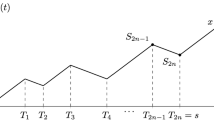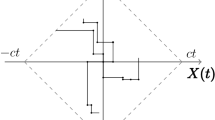Abstract
This paper deals with a new class of random flights in ℝd, d≥2, characterized by non-uniform probability distributions on the multidimensional sphere. These random motions differ from similar models appeared in literature where the directions are taken according to the uniform law. The family of angular probability distributions introduced in this paper depends on a parameter ν≥0, which gives the anisotropy of the motion. Furthermore, we assume that the number of changes of direction performed by the random flight is fixed. The time lengths between two consecutive changes of orientation have joint probability distribution given by a Dirichlet density function.
The analysis of the position \(\underline{\mathbf{X}}_{d}(t)\), t>0, is not an easy task, because it involves integrals which are not always computable. Therefore, we get the probability distribution of the process \(\underline{\mathbf{X}}_{m}^{d}(t)\), t>0, obtained as projection onto the lower space ℝm, m<d, of the original random motion in ℝd.
In its general framework, the analysis of \(\underline{\mathbf{X}}_{d}(t)\), t>0, is very complicated; nevertheless for some values of ν, we provide some explicit results about the process. Indeed, for ν=1 we get the characteristic function of the random flight moving in ℝd. By inverting the obtained characteristic function, we derive the analytic form (up to some constants) of the probability distribution of \(\underline{\mathbf{X}}_{d}(t)\), t>0.
It is worth to mention that the stochastic processes considered in this paper belong to the class of the non-isotropic random walks, which has several applications in the mechanical statistics.



Similar content being viewed by others
References
Barber, B.C.: The non-isotropic two-dimensional random walk. Waves Random Media 3, 243–256 (1993)
Beghin, L., Orsingher, E.: Fractional Poisson processes and related planar random motions. Electron. J. Probab. 14, 1790–1826 (2009)
Beghin, L., Orsingher, E.: Moving randomly amid scattered obstacles. Stochastics 82, 201–229 (2010)
De Gregorio, A.: Stochastic velocity motions and processes with random time. Adv. Appl. Probab. 42, 1028–1056 (2010)
De Gregorio, A., Orsingher, E.: Flying randomly in ℝd with Dirichlet displacements. Stoch. Process. Appl. 122, 676–713 (2012)
Di Crescenzo, A.: Exact transient analysis of a planar motion with three directions. Stoch. Stoch. Rep. 72, 175–189 (2002)
Franceschetti, M.: When a random walk of fixed length can lead uniformly anywhere inside a hypersphere. J. Stat. Phys. 127, 813–823 (2007)
Garcia-Pelayo, R.: Twice scattered particles in a plane are uniformly distributed. J. Stat. Phys. 133, 401–404 (2008)
Gradshteyn, I.S., Ryzhik, I.M.: Table of Integrals, Series and Products. Academic Press, New York (1980)
Grosjean, C.C.: Solution of the non-isotropic random flight problem in the k-dimensional space. Physica 19, 29–45 (1953)
Jakeman, E., Tough, R.J.A.: Generalized K distribution: a statistical model for weak scattering. J. Opt. Soc. Am. A 4, 1764–1772 (1987)
Lachal, A.: Cyclic random motions in ℝd-space with n directions. ESAIM Probab. Stat. 10, 277–316 (2006)
Lachal, A., Leorato, S., Orsingher, E.: Minimal cyclic random motion in ℝn and hyper-Bessel functions. Ann. Inst. Henri Poincaré Probab. Stat. 42, 753–772 (2006)
Le Caër, G.: A Pearson-Dirichlet random walk. J. Stat. Phys. 140, 728–751 (2010)
Le Caër, G.: A new family of solvable Pearson-Dirichlet random walks. J. Stat. Phys. 144, 23–45 (2011)
Masoliver, M., Porrá, J.M., Weiss, G.H.: Some two and three-dimensional persistent random walks. Physica A 193, 469–482 (1993)
Nossal, R.: Stochastic aspects of biological locomotion. J. Stat. Phys. 30, 391–399 (1983)
Orsingher, E.: Exact joint distribution in a model of planar random motion. Stoch. Stoch. Rep. 69, 1–10 (2000)
Orsingher, E., De Gregorio, A.: Random flights in higher spaces. J. Theor. Probab. 20, 769–806 (2007)
Pogorui, A.A., Rodriguez-Dagnino, R.M.: Isotropic random motion at finite speed with K-Erlang distributed direction alternations. J. Stat. Phys. 145, 102–112 (2011)
Samoilenko, I.V.: Markovian random evolutions in ℝn. Random Oper. Stoch. Equ. 9, 139–160 (2001)
Stadje, W.: The exact probability distribution of a two-dimensional random walk. J. Stat. Phys. 46, 207–216 (1987)
Acknowledgements
The author would like to thank the referees for their remarks and suggestions.
Author information
Authors and Affiliations
Corresponding author
Appendix
Appendix
In the random flight problem the integrals involving Bessel functions have a crucial role. For this reason in this section we summarize some important results which are often used in the paper.
In particular we focus our attention on the following integral
with α,β∈ℝ and ν≥0. We are able to calculate (4.1) in some particular cases. For example, for ν=0 it is well-known that
Now, we consider (4.1) for ν=n, with n≥1. Following the same approach adopted by De Gregorio [4], we derive an expression of the above quantity given by a linear combination of Bessel functions. The first step consists in expanding the exponential function inside the integral, that is
Hence, we observe that the above integral on (0,π/2), after a change of variable, is equal to zero if k and r are even. Therefore, one has that

Now, we have to handle the quantity
We observe that, after some suitable manipulations, we can write that
-
for n=1, \(\frac{2(k-r)+1}{r!(k-r)!}=\frac{1}{r!(k-r)!}+\frac{2}{r!(k-r-1)!}\);
-
for n=2, \(\frac{(2(k-r)+3)(2(k-r)+1)}{r!(k-r)!}=\frac {3}{r!(k-r)!}+\frac{12}{r!(k-r-1)!}+\frac{4}{r!(k-r-2)!}\);
-
for n=3, \(\frac {(2(k-r)+5)(2(k-r)+3)(2(k-r)+1)}{r!(k-r)!}=\frac{15}{r!(k-r)!}+\frac {90}{r!(k-r-1)!}+\frac{60}{r!(k-r-2)!}+\frac{8}{r!(k-r-3)!}\).
Then, we can argue that the following equality holds
where a j,n s are positive constants. For instance, the previous considerations lead to the following scheme

Unluckily, it is not possible to obtain the value a j,n for each n and j. Indeed, by performing the same calculations leading to (4.4), it seems that a recursive rule for an arbitrary integer n does not hold. Nevertheless, it is easy to see that
Finally, we get that

Important results are also the following ones
with \(\mathop{\mathit{Re}}\mu>-\frac{1}{2}\) and \(\mathop{\mathit{Re}}\nu>-\frac{1}{2}\) (see [9], formula 6.581(3)),
with Re(μ)>0, Re(ν)>0 (see [9], formula 6.533(2)),
with a≥b, Re(ν+1)> Re(μ)>0 (see [9], formula 6.575(1)), and
for Reν>−1 (see [9], p. 743, formula 6.688.(2)).
Rights and permissions
About this article
Cite this article
De Gregorio, A. On Random Flights with Non-uniformly Distributed Directions. J Stat Phys 147, 382–411 (2012). https://doi.org/10.1007/s10955-012-0471-4
Received:
Accepted:
Published:
Issue Date:
DOI: https://doi.org/10.1007/s10955-012-0471-4




